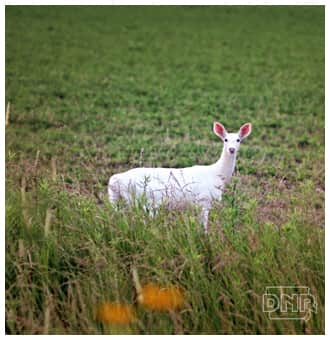Rare Albino Deer Spotted Repeatedly in Iowa
OutdoorHub Reporters 07.12.13

Parkgoers and residents living near Iowa’s Lake Macbride State Park can often sneak a peek of an albino deer living in the area. According to officials with the Iowa Department of Natural Resources, the doe often comes to a field beside a nearby highway to graze at night. The creature has become something of an attraction, drawing small groups of visitors. Passing drivers stop their vehicles and step outside to marvel at the animal, careful not to startle it.
Observers have reported that a regularly-colored fawn sometimes accompanies the white doe on her evening stroll.
Albino deer are incredibly rare and often regarded as beautiful. Given the right conditions, their white coats can be dazzling in the sunlight. The rare coloration of albino deer also make them easy targets for predators, however, and few of these animals survive into adulthood. Wildlife biologists estimate that only one in 100,000 deer are born albino.
Albinism is a condition that affects all vertebrates and can be seen in humans as well. Albino deer are markedly different from white deer, which carry recessive genes for all-white coats. One visual difference between the two is that all albino deer have pink facial features, notably the ears and nose.
It is customary in some areas for hunters to pass on albino and white deer, although traditions–and laws–vary depending on the region. In Iowa, lawmakers made it illegal to hunt predominantly white, whitetail deer in 1980. The harvest of a white deer in Wisconsin last year caused outrage both among the local community and some hunters. Others defended the hunter who made the harvest, which was legal under Wisconsin law.
As for the Iowa doe, wildlife officials believe that as the nearby Coralville Reservoir recedes to normal summer levels, the doe’s nighttime outings will begin to shorten. Already visitors have been reporting that the doe is seen less and less frequently.

